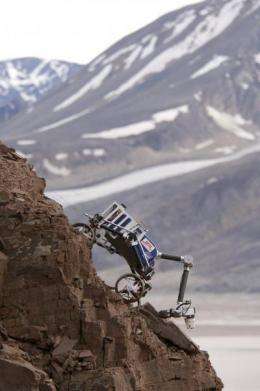New cleaning protocol for future 'search for life' missions

Scientists have developed a new cleaning protocol for space hardware, such as the scoops of Mars rovers, which could be used on future "Search for Life" missions on other planets.
The new protocol was developed as part of a project to investigate life that exists in extreme Arctic environments, which are the closest analogue we have on Earth to the surface of Mars. The studies are also designed to help guide future NASA and ESA planetary missions.
Published today in the journal Astrobiology, the decontamination protocol was developed and tested by scientists at the University of Leeds and NASA. It deals with the dilemma known as 'forward contamination' - ensuring that bugs from Earth don't hitch a ride across space and jeopardise the integrity of samples collected by rovers.
The decontamination protocol involves a cocktail of chemicals that were applied and tested on various sampling devices, including a glacial ice core drill and a rover scoop.
"We are trying to avoid a case of mistaken identity," says Professor Liane Benning, a biogeochemist from the University of Leeds and co-author of the paper.
"We know that on Mars, if present, any biological signatures will be extremely scarce. Therefore it is essential that we are able to minimise 'background noise' and to document just how clean our sampling devices really are before we use them," she adds.
"We are now able to fully decontaminate sampling devices in the lab and field to null levels of detectable organic biosignatures, before any samples are collected. Importantly, this new procedure doesn't just sterilise, but it also cleans off any trace organic molecules of dead organisms," says Professor Benning.
The work was carried out as part of the Arctic Mars Analog Svalbard Expeditions (AMASE) which uses Svalbard (a set of islands in the Arctic ocean at 74-80˚N) as an international test site for NASA and ESA "Search for Life" instrumentation scheduled to fly on future Mars missions.
Svalbard is an excellent terrestrial analogue environment to Mars as life is scarce and it has a similar geology and many pristine glaciers.
"This work also enabled recent habitability and biomarker preservation studies in the extreme glacial settings of Svalbard. In addition, this work will guide future planetary missions, especially those to icy regions in the Solar System, such as Mars, or the moons of Jupiter and Saturn (Europa and Enceladus) where we are interested in understanding the potential habitats of cold-loving organisms living in ice," says Dr Jennifer Eigenbrode, NASA research scientist.
This work was carried out during the 2005 and 2006 field seasons of AMASE and was funded by a NASA ASTEP award to co-author Andrew Steele at the Carnegie Institution of Washington and grants from the Earth and Biosphere Institute at the University of Leeds to Liane G. Benning.
Source: University of Leeds (news : web)
















